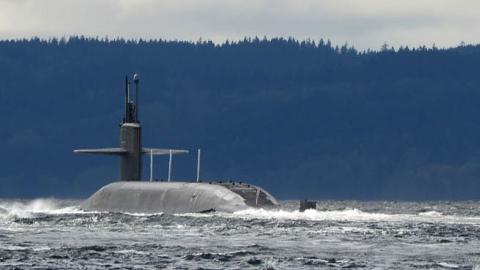On September 17th, the Senate Armed Services Committee held a hearing on the current partnership between the Departments of Defense and Energy concerning the U.S. nuclear deterrent. While the three Administration witnesses are highly professional public servants and have labored mightily to ensure the U.S. has the nuclear capabilities it needs in an increasingly dangerous and uncertain world; what the witnesses did not address is the 800 kiloton elephant in the room: the 20 year experiment to create a semi-autonomous nuclear weapons production complex within the Department of Energy (DoE). The U.S. is at a critical moment in the recapitalization of its deterrent, and adversaries (including Russia and China) are in the midst of a nuclear arms race. Time is of the essence to throw out this failed arrangement in favor of a new, fully independent cabinet department.
Since the United States Atomic Energy Commission (AEC) was dissolved in 1975, management of the nuclear weapons stockpile has, effectively, been entrusted to the Department of Energy (DoE). The decades that followed were marked by failures, waste, and even highly damaging espionage by nations like the People’s Republic of China. So, finally, 20 years ago this month, the House and the Senate passed legislation, on a veto-proof margin, to stand up a semi-autonomous agency – the National Nuclear Security Administration (NNSA) – to manage the nation’s nuclear stockpile, nuclear nonproliferation programs, and naval nuclear reactors. At the 20-year point, it is entirely appropriate to consider whether this half measure worked, and, if not, is now the time for a more radical change?
There has long been an awkward “blended family” arrangement to manage the U.S. nuclear deterrent: the Department of Defense (DoD), a civilian-run agency, sets the requirement for how many nuclear weapons of what types the nation needs to satisfy the President’s nuclear weapons guidance, but it leaves the actual production of the nuclear weapons to another civilian-run agency: the Energy Department’s NNSA.
DoD develops, procures, and deploys multi-billion weapons systems, like nuclear powered ballistic missile submarines, land-based intercontinental ballistic missiles, heavy bombers, and other systems. But, as sophisticated as these weapon systems are, they’re effectively paperweights without the "bullet in the chamber," the nuclear weapon, that the NNSA produces and maintains.
This has, understandably, always been a fraught relationship between large bureaucracies. While the DoD’s mission is relatively single-focused on national defense, the DoE has varied missions. It was established to help the nation prevent another energy shock of the type it faced in the Arab oil embargo of the early 1970s. Its priorities range from fossil fuels to solar panels to nuclear waste dumps to artificial intelligence and electric utility rates. It’s worth noting that other than the national defense mission of the NNSA, DoE's other missions are exclusively civilian.
DoE's first leader, former Secretary of Defense James Schlesinger, was perhaps the first and last hired with any actual nuclear weapons experience (having been Chairman of the Atomic Energy Commission). Most Secretaries are hired because they’re energy experts, understandably. As a result, most ignore the nuclear weapons mission, content to leave it in a radioactive bureaucratic box. Yet, this is Washington: no bureaucrat wants to lose responsibility for a mission (or its budget – especially not 50% of it). Since the NNSA was created as a semi-autonomous entity with DoE, Secretaries of Energy have bridled at this arrangement: while the head of the NNSA is subject to the control of the Secretary, the agency is supposed to otherwise be beyond the reach of the Department of Energy and its bureaucracy.
But these two massive departments, DoE and DoD, have ultimately been able to work together – often at greater cost in time and dollars than should have been needed – because of a statutory system of coordination and cooperation. Congress established the Nuclear Weapons Council (NWC) to coordinate budget requests between the two departments, synchronize acquisition and modernization cycles, and prepare the annual Nuclear Weapons Stockpile Memorandum,Secretaries%20of%20Defense%20and%20Energy.&text=It%20is%20the%20directive%20signed,by%20the%20Atomic%20Energy%20Act. for the President, wherein he determines the size and composition of the U.S. nuclear weapons stockpile.
And today, the NWC is headed by Undersecretary for Acquisitions and Sustainment Ellen Lord, marking the first time that the U.S. nuclear weapons stockpile has been managed by two women (i.e., Lord and NNSA Administrator Lisa Gordon Hagerty), a shattering of the nuclear glass ceiling. Together with senior uniformed leaders, including General John Hyten, USAF, the Vice Chairman of the Joint Chiefs of Staff, and Admiral Charles “Chas” Richards, USN, Commander of U.S. Strategic Command, the DoD and NNSA systems appear to be succeeding in the hard, but critical, work of ensuring the reliability and credibility of the nation’s nuclear deterrent.
For example, in the process to produce the Fiscal Year 2021 budget request, the NWC learned that the NNSA budget submission, as reviewed and approved by the Department of Energy and the Office of Management and Budget, was going to be woefully short of the requirements needed to meet the Department of Defense’s requirements, as determined by the President. Ultimately, the President agreed with the budget requirements initially identified by the NWC. While some in the White House Office of Management and Budget and DoE were not pleased that the President sided with the NNSA and the NWC and not them, the system worked because the President had the information and options to make his decision.
Unfortunately, those who were on the losing side appear not to have accepted that decision. For example, after the President made his decision about the Fiscal Year 2021 budget request, an effort has been underway to strip both the Nuclear Weapons Council and the NNSA Administrator of her responsibility for coordinating the NNSA budget with DoD’s. There is no winner in this effort to sabotage the Nuclear Weapons Council. But these institutional jealousies are not new; they are long-standing symptoms of previous half measures to address the organization and governance of the U.S. nuclear weapons production enterprise.
Early in the 2010s, Congress recognized that DoE's partial implementation of semi-autonomy, as required by the NNSA Act, was a risk to the U.S. nuclear deterrent. The NNSA, which itself has accreted tremendous bureaucratic bloat over the years as a lazy response to mistakes, mismanagement, and congressional and press pressure, was also drowning in micromanagement from "Big DoE."
Notwithstanding the NNSA Act, which provided that, as a matter of law, only the Secretary and Deputy Secretary of Energy can direct NNSA, through the Administrator, the Department's bureaucracies had regularly interfered with the NNSA's activities. Countless layers of oversight of the overseers meant DoD weapons were regularly late and over-budget (often resulting in the Pentagon being asked to foot the bill) because no one in the DoE bureaucracy or NNSA field offices had the authority and will to say "yes" and anyone could say "no." Instead of accountability and responsibility by the Secretary and the NNSA Administrator, as specified in law, it was spread around a dozen bureaucratic fiefdoms.
So, Congress established the Augustine-Mies Advisory Panel on the Governance of the Nuclear Security Enterprise to propose solutions for this dysfunctional arrangement. In its final report, the panel members found that “the existing governance structures and many of the practices of the [nuclear weapons] enterprise are inefficient and ineffective, thereby putting the entire enterprise at risk over the long term. These problems have not occurred overnight; they are the result of decades of neglect.”
The panel proposed a wide-ranging overhaul of both the Department of Energy and the NNSA, including reorganizing and renaming the Department itself to reflect a priority on the nuclear deterrent. The panel also made a recommendation that, if those changes were not undertaken within two years, the NNSA must be made "an independent, autonomous agency. ” Six years, two Administrations, and multiple Congresses later, the reforms have not been made. And, bureaucratic infighting – and gamesmanship with bureaucratic allies on Capitol Hill – again threatens the U.S. nuclear deterrent.
In a March 2000 hearing, the Chairman of the Special Oversight Panel on Department of Energy Reorganization of the House Armed Services Committee, Mac Thornberry (R-TX), stated, “if we cannot make this work within the Department of Energy, there are a number of our colleagues who want to remove it entirely.” Twenty years after the passage of the NNSA Act, and a mountain’s worth of GAO and independent commission reports later, it’s clear that there is only one option left: the Executive Branch and the Congress need to establish an independent, cabinet level agency, answerable to the President, to provide the U.S. and its allies the nuclear deterrent it needs today and for the foreseeable future.
The nuclear deterrent is the ultimate guarantor of U.S. and allied security. The nation’s senior civilian and military leaders have been clear it is the number one priority to protect the homeland. We cannot continue to risk unilateral nuclear disarmament by bureaucratic neglect. The time for change is now.
Read in RealClear Defense
















